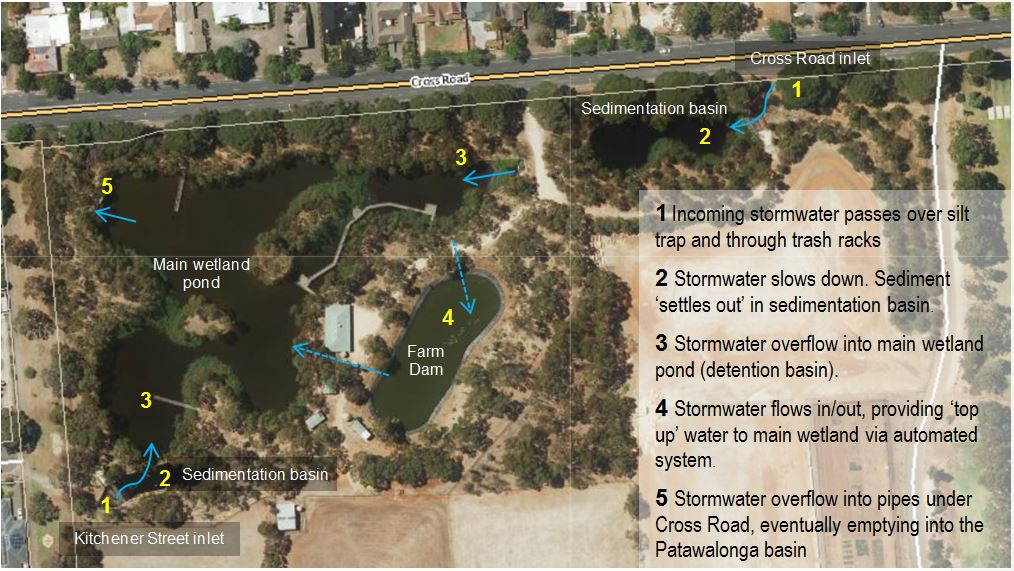Urrbrae Wetland is a working and teaching wetland located at Urrbrae Agricultural High School in Netherby. Urrbrae Wetland is an example of what can be achieved when local and state governments and the community work together.
In the early 1990s the City of Mitcham began investigating a solution to resolve flooding along Cross Road, while Urrbrae Agricultural High School wanted to stop frequent flooding on its farmland and broaden its environmental curriculum. They joined forces and the wetland was born.
The Urrbrae Wetland was officially opened in April 1997 by the Premier John Olsen. Construction was funded by the State Government, former Patawalonga Catchment Water Management Board and Council.
The successful integration of the Urrbrae Wetland wild aquatic and plant life within an urban environment has created a unique learning experience.
How does it work?
Urrbrae Wetland is a stormwater ‘detention basin’ to reduce local flooding, while incorporating characteristics of a wetland.
The quality of stormwater leaving the wetland is improved by removing litter and organic material through trash racks and sediment in the ponds. Other pollutants ‘settle out’ of the water, while some are broken down by ultra-violet radiation from the sun.
For more information on the Urrbrae Wetlands, please visit the Urrbrae Wetland Learning Centre site.

Schools are welcome to visit the Urrbrae Wetland. To book a tour
Call 8274 7443
The work of the volunteer group ‘Friends of the Urrbrae Wetland' is an essential part of the Urrbrae Wetland. They meet every Tuesday from 8.30am to 12noon and work on maintenance, planting, watering, weed eradication, open days and guided tours. You can follow the Friends of the Urrbrae Wetland on Facebook
Their work in caring for the wetland has created an extraordinary ambience about the wetland. They have turned a plant free, barren site into a wonderful indigenous, landscaped garden and seed bank as it might have been in 1836 prior to European settlement and land clearance.
The volunteers have also created a most relaxing and invigorating experience for the visitor and the surrounding suburbs.
For further information, contact the City of Mitcham on 8372 8888 or the Urrbrae Wetland Manager on 8274 7443.
Approximately 100 local native terrestrial and aquatic plant species have been planted to maximise diversity, habitat and serve as a resource (nursery) for other projects.
Over 90 bird species have been sighted, and four species of bats. Water based animals include four frogs and over 50 macro invertebrate species, Murray River Rainbow fish, Mountain Galaxia and yabbies.
One of the landscaping aims at the Wetlands was to recreate a landscape as it might have been in 1836, prior to European settlement.
Since 1997, the wetland site has been vegetated by students and Friends of Urrbrae Wetland, using plants grown from seed or cuttings of local provenance. These have been collected under permit in the Mitcham foothills, Southern Adelaide Plains, Belair National Park and the Lower Sturt River.
Some of the species planted include: Grey Box (Eucalyptus microcarpa), South Australian Blue Gum (Eucalyptus leucoxylon subsp leucoxylon), River Red Gum (Eucalyptus camaldulensis), Sweet Bursaria (Bursaria pinosa), Golden Wattle (Acacia pycnantha), Kangaroo Thorn (Acacia paradoxa), Native Lilac (Hardenbergia violacea) and Kangaroo Grass (Themeda triandra).
In an aquatic environment, plants play a key role in reducing water velocity, removing nutrients, oxygenating water and providing habitat and food for fauna. Aquatic plants common to the wetland include the Common Reed (Phragmites australis) and other sedges and rushes.
Quick Facts
- 6,000+ visitors each year
$1.7 million - construction cost of Stages 1 and 2
$0.93 million - grants for construction costs of Stages 1 and 2 - 4.5 hectares for the site
1.5 hectares of water area
375 hectares is the catchment area - 380 million litres of stormwater enters the wetland each year (long term average)
14.6 million litres - stormwater detention capacity
10 million litres – capacity of clay-lined, wetland pond (detention basin)
3 million litres – capacity of synthetic lined Farm Dam - 2 stormwater inlets
2 sedimentation basins
1 detention basin
Benefits of Urrbrae Wetland
- Reduces the frequency of local flooding
- Reduces pollutants and pathogens in stormwater entering the Patawalonga basin,
- Research and education facility for the community
- Habitat for local native animals and plants
- Stormwater for irrigation
The wetland is situated on the southern side of Cross Road about 500 metres east from Duthy Street and 500 metres west of Fullarton Road. Look for the large entrance sign and double gates.
To book a tour and find out when the next open day is:
Call 8274 7443
